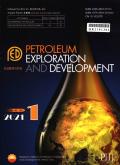Fracture initiation and propagation in soft hydraulic fracturing of hot dry rock
IF 8
Q1 ENERGY & FUELS
引用次数: 0
Abstract
By considering the thermo poroelastic effects of rock, the constitutive relationship of fatigue deterioration of rock under cyclic loading, elastic-brittle failure criteria and wellbore stress superposition effects, a thermal-hydraulic-mechanical- fatigue damage coupled model for fracture propagation during soft hydraulic fracturing in hot dry rock (HDR) was established and validated. Based on this model, numerical simulations were conducted to investigate the fracture initiation and propagation characteristics in HDR under the combined effects of different temperatures and cyclic loading. The results are obtained in three aspects. First, cyclic injection, fluid infiltration, pore pressure accumulation, and rock strength deterioration collectively induce fatigue damage of rocks during soft hydraulic fracturing. Second, the fracture propagation pattern of soft hydraulic fracturing in HDR is jointly controlled by temperature difference and cyclic loading. A larger temperature difference generates stronger thermal stress, facilitating the formation of complex fracture networks. As cyclic loading decreases, the influence range of thermal stress expands. When the cyclic loading is 90%pb and 80%pb (where pb is the breakdown pressure during conventional hydraulic fracturing), the stimulated reservoir area increases by 88.33% and 120%, respectively, compared to conventional hydraulic fracturing (with an injection temperature of 25 °C). Third, as cyclic loading is further reduced, the reservoir stimulation efficiency diminishes. When the cyclic loading decreases to 70%pb, the fluid pressure far away from the wellbore cannot reach the minimum breakdown pressure of the rock, resulting in no macroscopic hydraulic fractures.
干热岩石软水力压裂裂缝起裂与扩展
综合考虑岩石热孔弹效应、循环加载下岩石疲劳劣化的本构关系、弹脆破坏准则和井筒应力叠加效应,建立并验证了热干岩软水力压裂裂缝扩展的热-水力-力学-疲劳损伤耦合模型。基于该模型,通过数值模拟研究了不同温度和循环载荷共同作用下HDR裂纹的起裂和扩展特性。得到了三个方面的结果。首先,循环注入、流体渗透、孔隙压力积累和岩石强度劣化共同导致了软水力压裂过程中岩石的疲劳损伤。②HDR软质水力压裂裂缝扩展模式受温差和循环载荷共同控制。温差越大,热应力越强,有利于形成复杂裂缝网络。随着循环载荷的减小,热应力的影响范围逐渐扩大。当循环载荷为90%pb和80%pb (pb为常规水力压裂破裂压力)时,与常规水力压裂(注入温度为25℃)相比,增产储层面积分别增加了88.33%和120%。第三,随着循环载荷的进一步减小,储层增产效率降低。当循环载荷降低到70%pb时,远离井筒的流体压力无法达到岩石的最小破裂压力,导致宏观水力裂缝未形成。
本文章由计算机程序翻译,如有差异,请以英文原文为准。
求助全文
约1分钟内获得全文
求助全文

 求助内容:
求助内容: 应助结果提醒方式:
应助结果提醒方式:


